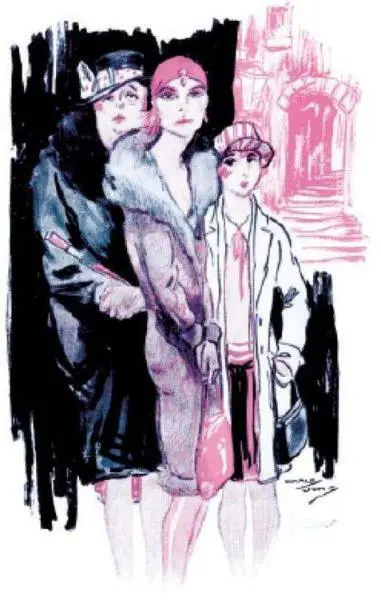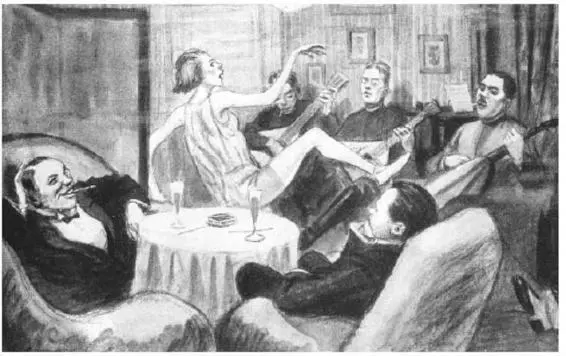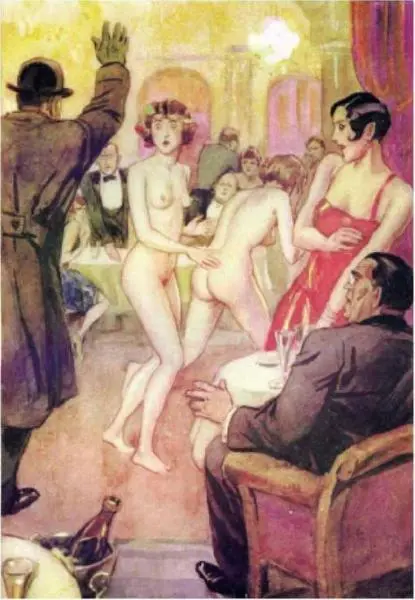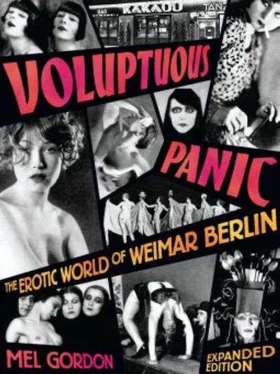The municipal chiefs of the great city had little to say about prostitution, which, resulting from an oversupply of females (primarily war-widows), had shown a massive increase since the Armistice. The dignitaries had other moral concerns. Two public acts were now strictly forbidden: fishing by hand grenade in the lakes and rivers around Berlin, and social dancing inside the city bounds. On a single day in January 1919, five dance halls were raided by Berlin vice squads while frumpy streetwalkers and cocaine-Schleppers watched in bemused stupefaction.
Through much of 1919, Berlin waged a war against the promoters of popular dance. But the universally reviled campaign was doomed from the start. A delirium for social dance ( Tanztaumel ) had swept the city and much of Germany since the cessation of fighting. Klaus Mann, the son of the Nobel Prize laureate, recalled the choreographic outbreak as “a mania, a religion, a racket.” Secret dance parlors, hidden in the Friedrichstadt and in Berlin North, became the craze. In workers’ quarters, Apache-like tango dances, cakewalks, and foxtrots played out under streetlights and in parks. Life in postwar Berlin had become bizarrely eroticized and dance-madness was its improbable visible symptom.
Social and popular dances took place in an array of venues: at lavish balls (like the Bad Boys’ Ball or the Pretty Leg Festival), in sleazy corner bars, at private clubs near resort areas, but mostly it was stimulated by imported American music and the new women’s fashion that emphasized silk stockings and revealing skirts. What was once the shocking mode of film stars and drunken aristocrats now availed itself to everyone. Even at formal dances, clothing shrank to practically nothing. Variety houses and cabarets featured rows of naked women, but many found it impossible to compete with the risqué styles in the audience.

Carlo Jung, A Fine Family
At first the city made a purely Kantian appeal: if every Berliner tripped the light fantastic, full economic recovery could never be achieved. But there was a growing sense of prosperity in Berlin anyway. Despite the ubiquitous presence of beggars and hideous war-wounded, demobilized aristocrats and the children of Germany’s affluent classes gravitated to the country’s financial and cultural center.

W. Krain, Berlin Illustrirte Zeitung, Naked Dance , 1920
Then thousands of posters from the health ministry warned, “Berlin, Your Dance Partner is Death!” The admonishment in garish Expressionist script weirdly coupled brain-damaging syphilis with all-night tangos. In no time, the slogan inspired trunkloads of caustic sketches by cabaret artists and provided the ideal catchphrase-refrain for dozens of dialect song parodies.
In April 1919, a new tactic was tried. A few of the largest dance halls were allowed to reopen. However, ballroom dance remained verboten elsewhere in Berlin. Closures of defiant bars, mass arrests, and costly law-suits resulted. By late fall, the entire civic enterprise had to be abandoned. The city fathers discredited themselves with their silly exercise in extreme social rectitude. Dance was made legal and censorship in Berlin basically ceased.
A dizzying panic overtook Berlin in October 1919. Not since Paris in the 1860s had a European city experienced the Edenic flush of total erotic freedom. With prostitution and all-night dancing already accepted features of contemporary Berlin life, what else could be added? Drugs and over-the-counter pornography appeared first.
Cocaine powder, morphine solution in vials, and opium balls were hawked on street corners. Chinese entrepreneurs from the former German concession of Kiaochow installed a string of opium dens in Friedrichstadt cellars, but these were far too claustrophobic for German tastes. Invented sedatives—like Anita Berber’s breakfast elixir, chloroform and ether—seemed more modern and daring. (The C-and-E cocktail was ingested by swirling white roses in the potion and then biting off the frozen petals. Really the designer drug of its time.)
The most sought-after pornographic postcards and films had been imported from Paris or Budapest before the war. Now Berlin was patriotically producing its own brands in oversized graphic portfolios, “bachelor” Galante magazines, photo-sheets, and smokers. Even German nudist journals that were published for decades took on darker tones. The sweet qualities of Gallic porno were supplanted in Berlin studios by the psychopathic scenarios from Krafft-Ebing. Forced, intergenerational, scatological, and obsessive fetish sex prevailed. Sunny pics of bob-haired, smiling French beauties in nude repose (often in sylvan settings before gleaming, immobile sedans) gave way to queasy, regressive fantasies—Gymnasium masters and nannies administering instruments of torture and humiliation to their naked charges. The distinct erotica of Berlin was sold in specialized bookstores and here and there on the street.
The Nachtlokal , or private nightspot, was another crude expression of the new era. In 30 or so Berlin hideaways, gentlemen and sophisticated couples could encounter the latest erotic sensation, the Naked Dance. Cynical journalists compared these postwar Berlin “nightclubs” to Tingel-Tangels , ugly Wilhelmian whore-bars where honky-tonk entertainers intermingled with their equally lowbrow clients. In truth, the Nachtlokals catered to a much more naive class of patron.

Erich Schütz, Raiding the Nacktlokal
Usually the potential customer was discovered on a midnight Bummel (urban stroll) somewhere near the Friedrichstadt. A scruffy teen working for the Lokal , the Schlepper , would then approach the target, luring him with promises of covert erotic entertainment and, if alone, female companionship. A picturesque journey through a Byzantine circuit of courtyards and passageways followed. Finally, the disoriented sucker was delivered to the secret club hidden in an out-of-the-way apartment complex. Once inside, the Suitor paid a horrific tariff (in the form of an overpriced bottle of German champagne, Sekt ) just to sit at a table. An improbably upbeat Russian balalaika band normally filled the air with musical static.

Around one or two in the morning, a smutty revue commenced. The nature and duration of the show varied considerably, mostly consisting of few naked whores and their daughters, prancing in mock Isadora abandon. Poor sightlines and erratic seating arrangements were offset by the itinerant activities of the performers, who would erotically tease Suitors at their tables and join free-spending customers for more brazen contact. Genital frisson in the form of lap-dancing or foot-sex (with the woman perched on the tabletop) was a customary enticement.
Newspapers and magazines had a field day exposing these tourist traps. The kitschy symbol of a nineteenth-century orgy, bald-headed men downing Sekt from the shoes of giggling whores, appeared repeatedly in their pages as sidebar photographs and sketches. (Waggish columnists opined that such a practice must have enhanced the inferior quality of the foaming swill.)
Читать дальше
















